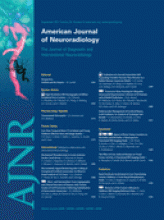Supplemental Online Appendix
Files in this Data Supplement:
- Online Appendix (PDF) -
Section 1: Postprocessing Method
Section 2: Supplemental Results
Fig S1: Example of motor LAD measurement. This illustrates an example of the distance measurement made from tumor margin to periphery of functional activation in a patient with Grade III, right fronto-parietal astrocytoma (t > 10). The yellow arrow demarcates the right inferior/lateral primary sensorimotor cortex, while the pink arrow defines the distance of interest (i.e. LAD).
Fig S2: Kaplan-Meier curves for the motor patient population. (Log Rank test, P = .018) Kaplan-Meier curves for the motor data indicates survival time for patients with either preoperative or postoperative motor deficit (blue) was significantly longer (mean = 2233 days, 95% CI = 1958 to 2508 days) than for patients with both preoperative and postoperative motor deficits (green; mean = 1544 days, 95% CI = 1046 to 2042; Mantel-Cox Log-Rank test, Χ2 = 5.61, P = .018).
Fig S3: Kaplan-Meier curves for the language patient population. (Log Rank test, P = .079) Kaplan-Meier analysis indicates that survival time for patients with either preoperative or postoperative deficit (blue) was longer (mean = 2306 days, 95% CI = 2013 to 2599 days) than for patients with both preoperative and postoperative deficits (green; mean = 1282 days, 95% CI = 847 to 1718 days), however, this difference only trended towards significance (Mantel-Cox Log-Rank test, Χ2 = 3.08, P = .079).
Online Table 1: Patient clinical data
Online Table 2: Demographics of patients who underwent surgery
Online Table 3: Univariate analysis: Results for subset of patients who underwent surgery
Online Table 4: Broca versus Wernicke aphasia
Online Table 5: Survival analysis using Cox-proportional hazards
Online Table 6: Models with interactions
- Online Appendix (PDF) -
AJNR Awards, New Junior Editors, and more. Read the latest AJNR updates












